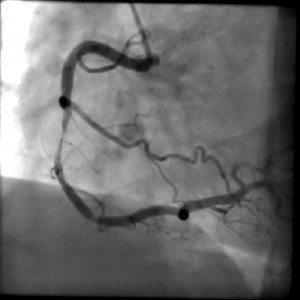 Download this patient information sheet
Download this patient information sheet
Coronary Angiography (literally “taking pictures of the blood vessels of the heart”) is an invasive procedure performed in hospital after appropriate evaluation, to identify any narrowings or blockages of the heart arteries.
Coronary angiography is performed to show up the amount of disease or narrowing to the heart or coronary arteries. This may help establish the cause of symptoms such as chest pain, shortness of breath or other problems. It also helps to establish the best way to treat this heart disease.
Coronary Angiography is only performed by a suitably trained cardiologist, in a hospital. After an injection of local anaesthetic, a fine tube (catheter) is put into the artery, usually at the top of the leg or at the wrist. The tube is carefully passed into each coronary artery in turn, under X ray guidance.
A series of video pictures is taken using x-rays and a contrast medium (x-ray dye). The contrast medium may be injected into the main pumping chamber of the heart (left ventricle). This is to measure the size of the heart and how well it is pumping. These pictures give us a map of the coronary arteries. This helps us to find out whether you have any narrowing or blockage of your coronary arteries.
We can then tell you which treatment is best for you. This may be an operation such as coronary by-pass or a procedure called a coronary stent (a very fine metal mesh sleeve put into the artery wall by inflating a small balloon in the artery – see Coronary Intervention). Sometimes, drugs alone may be a suitable option.
Yes. Your cardiologist will usually be the person suggesting you undergo coronary angiography, usually after having performed other tests. You will need to have a blood test a few days before the test. You will be fasting (no breakfast or drink) on the morning of the test. You will have tell your cardiologist if you have had a contrast (x-ray dye) reaction before; in this case, special precautions are needed. Your cardiologist may instruct you to take certain blood thinning drugs in preparation for a coronary angiogram, and in general you should continue all your usual pills, unless instructed otherwise.
As you might expect with a procedure that involves placing something in the body, there are small risks associated with coronary angiography. These risks depend on:
These are some of the more serious risks that can happen, but are not the only risks:
Less than 1 in 10,000 people:
(a) Skin injury from radiation, causing reddening of the skin.
1 in 1,000 people:
(b) A stroke. This can cause paralysis and long term disability.
(c) Heart attack.
(d) A dangerous reaction to the x-ray contrast medium (dye). This can cause severe reactions such as asthma, shock and convulsions. Death in extremely rare cases – about 1 in 250,000 to 400,000 injections.
(e) Need for major surgery to the leg at the puncture site.
(f) Need for emergency heart surgery or angioplasty.
(g) A higher lifetime risk of cancer from x-ray exposure
(h) Death
1 in 100 people:
(i) The heart may not beat with a proper rhythm, which will need urgent treatment.
(j) Surgical repair of the groin puncture site. This may need a longer stay in hospital.
(k) Minor reaction to contrast medium such as hives.
(l) Loss of kidney function due to the contrast medium.
1 in 20 people:
(m) Major bruising or swelling at the groin or wrist puncture site.
(n) Minor bruising.